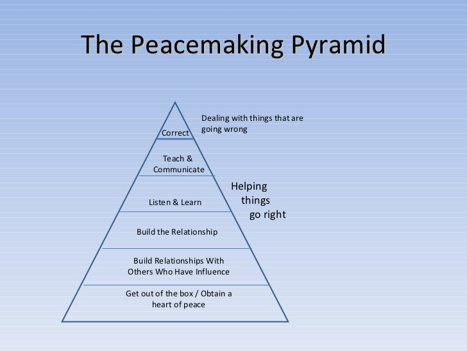The peacemaking pyramid: Building a better relationship with your employees
Troubled managerial-employee relationships seem to be getting even worse at the moment, in times of crisis and remote management.
That is difficult ……. and at the same time this distance is also an excellent opportunity to improve the relationship. Especially because there is distance, you can delve a little more (away from the frustration and emotion) into the other. Trying to find out what’s really going on. And what you can do to improve it. So that you can make a fresh start later.
 Often, as teachers, as parents or as supervisors, we spend relatively much time correcting things that are not going well. Or correcting (the behaviour of) the other.
Often, as teachers, as parents or as supervisors, we spend relatively much time correcting things that are not going well. Or correcting (the behaviour of) the other.
Often there is also an offended justification for yourself: “I want to teach them something / I want to help / I do it for them anyway…. and then they are behaving so difficult! “
The concept “The peacemaking pyramid” from the book “Anatomy of peace” can help you with this. Instead of focusing on what goes wrong, we can look at the levels below it. And seek improvement there.
Do you seem to have such a disturbed (work) relationship in which you have tried everything, but still cannot get anything done?
Then this reading tip is for you.
1. Reading tip: Anatomy of Peace – The Arbinger Institute
 “You have the choice at any time and in any situation to see the other as an object or to see the other as a person. That’s not always easy, and sometimes very difficult, but we can choose to try it anyway. We always have the opportunity to see the other person as human. “
“You have the choice at any time and in any situation to see the other as an object or to see the other as a person. That’s not always easy, and sometimes very difficult, but we can choose to try it anyway. We always have the opportunity to see the other person as human. “
– from “Anatomy of Peace” by The Arbinger Institute.
Easy-to-read book, written in novel form, that confronts you with your own behaviour in relation to others and that prompts you to think about changing this behaviour.
Three of the (many) models and concepts that I think are reason enough to give this book as a reading tip:
The Peacemaking Pyramid | Heart at war – heart at peace | How you see yourself influences how you see others, how you see the world and how you feel.
In the second part of this blog a guide on how to make the change.
The Peacemaking Pyramid
 The Peacemaking Pyramid assumes that you always have to solve a problem at a deeper level.
The Peacemaking Pyramid assumes that you always have to solve a problem at a deeper level.
- If we need to correct, we may not have explained it properly.
- If explanations and communication are not successful, we may not have delved into the other person, so we may not have listened properly to understand.
- We may not be able to listen and understand properly, because we may not have built a good relationship with the other person (yet).
- We may have a bad relationship with other people who are important to the other person.
- Or… most importantly: we work from our own “box”, our own experience, from a “heart at war”.
Question: At what level do you now spend the most energy with this employee?
Question: At what underlying levels do you have something to do? How can you do that now?
The next part is about the bottom level, your basic posture. Because whatever you do, the basic attitude from which you work makes a difference in your relationship with others
Heart at war
If you work from a “heart at war”, then you do not actually see the other person as a fully-fledged, equal person, but as a means or obstacle towards your goal.
If you work from a “heart at peace”, you see the other person as full, as a person with needs, worries and fears, just like you. Then you work from the sincere desire to help the other person.
A “heart at war” does not mean that you want bad things for the other person or that you are looking for a fight. You probably have very good intentions.
But the more attached you are to the result you expect from the other, or how you feel it should be, the more inclined you will be to perceive the other as an obstacle. The other does feel that, although he may not be aware of it. It disrupts the (work) relationship you have with someone.
How you see yourself influences how you see others, how you see the world and how you feel.
 The book distinguishes 4 “boxes”, which indicate how you see yourself and which ensure that you are “heart at war”. What those boxes look like and what steps you can take to get out are described in the next part
The book distinguishes 4 “boxes”, which indicate how you see yourself and which ensure that you are “heart at war”. What those boxes look like and what steps you can take to get out are described in the next part
2. Get out of your box!
A “heart at war” does not mean that you consciously want bad things for the other person or that you are looking for a fight. You probably have very good intentions.
A “heart at war” does mean that you work from your own “box”, from your own perspective and perception. It is then interesting to discover from which “box” you are working unconsciously.
Which box are you in?
The book distinguishes 4 “boxes”, which indicate how you see yourself and which ensure that you are “heart at war”:
- I’m better than … (better-than box)
- I earn… .. (I-deserve box)
- I should be seen as…. (Must-be-seen-as box)
- I’m worse than … (worse-than box)
How you see yourself influences how you see others, how you see the world, and how you feel.
Example: Do you quickly see others as lucky ones, as people with more opportunities and more privileges? Then it may be that you are in the worse-than box (see image below). Then you see yourself (unconsciously?) As less good than others. The world is hard for you then, seems to be against you and overlooks you. It can make you feel helpless, jealous and depressed. That influences your attitude towards others.
Do you feel that you are doing well, but that you are not appreciated? (I-deserve box). Then you will soon see other people as ungrateful people who are wrong. The world then looks unfair and unjust to you. You feel like you are entitled to something and you can start to feel resentment. Can you imagine what that does to your approach to other people?
 Question: What about the “better-than” box, and the “must-be-seen-as” box? Try to think for yourself how it affects your attitude to life. And how that influences your approach to other people.
Question: What about the “better-than” box, and the “must-be-seen-as” box? Try to think for yourself how it affects your attitude to life. And how that influences your approach to other people.
Question: Which box do you recognize most by yourself? And which do you think you recognize with a significant other?
From a “heart at war” to a “heart at peace”
If you want to get out of your box, these four steps help:
1. Find out which box you are in.
Which of the above resonates the most with you, which one is the most correct? What do you see in your behaviour? Be honest with yourself, even if you find that box objectionable. Acceptance is the only way to be able to change, denying and suppressing it does not help.
2. Try to find an “out-of-the-box” feeling.
You can. There was a time or a place where you felt different, where you did not feel better, offended, worse, etc. Think of other relationships, memories, something you did, a place where you
were, where you felt free and unthreatened. A good coach can also help you change perspective.
3. From this out-of-the-box feeling, look again at the situation and the relationship.
Hold on to that feeling and ask yourself, in relation to the employee you had in mind at the beginning of this article:
-
- What is the other person afraid of? What hurts ? What does bother him?
- How do I contribute to his fear, pain and burden? How do I harm the other person even more?
- How does my box influence my image of the other person, and how does that get in the way of a solution?
- What can I do now to make it better? How do I feel about what I have to do now?
4. Do what you have to do to stay out of the box.
================================================== ===================
3. Get started
 Do you want to dive into this a but further or get started right away?
Do you want to dive into this a but further or get started right away?
Feel free to immediately plan a half hour sparring with Sandra Geelink directly in the agenda.
